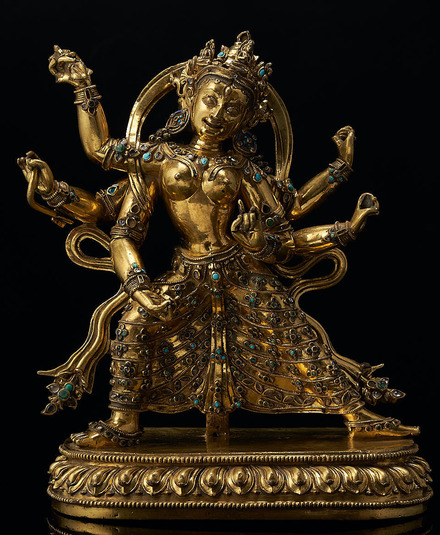
Item: Parnashavari (Buddhist Deity) - (three faces, six hands)
| Origin Location | Tibet |
|---|---|
| Date Range | 1300 - 1399 |
| Lineages | Kagyu and Buddhist |
| Material | Metal, Mercuric Gild |
| Collection | Private |
Classification: Deity
Appearance: Semi-Peaceful
Gender: Female
Parnashavari (Tibetan: ri tro ma, lo ma gyun ma. English: the Mountain Ascetic Wearing Leaves), the goddess who protects from contagious illness. (This sculpture most closely resembles HAR #32081).
Video: Parnashavari & Janguli Comparison
"...Parnashavari, yellow, three faces, right white, left red, with three eyes. Adorned with fruit, leaves and jewel garments. With six arms the three right hands hold a vajra, axe and arrow. The three left hold have a wrathful gesture and lasso, a fan of fruit and leaves, and a bow. The hair is tied with a string of flowers." (Mitra. rgyud sde kun btus. Volume 23, page 156).
Parnashavari: - Axe (right hand) - Fan of new leaves (left hand) - Lower garment new leaves
This figure is very close in appearance to Janguli and with sculptural examples it is very difficult to distinguish between the two iconographic forms.
[50] Arya Janguli. Arya Janguli, yellow, with three faces. Having a hood of seven snake heads. [Each face] has three eyes and the faces are [both] smiling and fierce. The six right hands hold a vajra, sword and an arrow, in a dancing manner. The left [hands hold] a wrathful [gesture] together with a lasso, a blue poisonous flower and a bow. Adorned with flowers and snakes. Standing in a dancing manner. (Bari Gyatsa, Konchog Lhundrub, 1497-1557).
Janguli: - Seven Snake Heads - Sword (right hand) - Blue poisonous flower (left hand) - Snake ornaments
Jeff Watt 2-2021
Tibet: Densatil (Deities - Miscellaneous)
Buddhist Deity: Parnashavari Iconography
Tibet: Densatil Monastery Style Sculpture
Buddhist Deity: Parnashavari (Sculpture Masterworks)
Buddhist Deity: Parnashavari (Mitra Tradition)
Buddhist Deity: Parnashavari & Janguli Comparison








